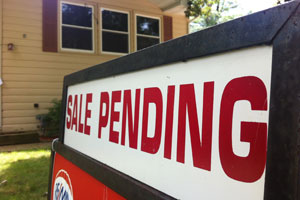Pending Home Sales Rise in September

Contracts to purchase previously owned homes rose less than forecast in September, showing housing will take time to gain momentum.
The pending home sales index increased 0.3% after dropping 1% in August, the National Association of Realtors said today in Washington. The median projection in a Bloomberg survey of economists called for a 1% gain.
Still-tight credit and low inventories remain hurdles for a sluggish housing recovery that’s still healing more than five years after the downturn. More Americans are being helped by faster progress in the employment picture, allowing those who are able to get a mortgage the opportunity to take advantage of historically low rates.
“We see few signs now of further momentum,” Ian Shepherdson, chief economist at Pantheon Macroeconomics Inc., said in a research note. “We are hopeful, however, that the dip in mortgage rates in recent weeks, coupled with the continuing improvement in the labor market, will trigger at least a modest renewed upturn by the end of the year.”
Estimates in the Bloomberg News survey of 41 economists forecasting pending home sales ranged from a decline of 1.5% to an advance of 2.5%.
Purchase contracts climbed 1% in the 12 months ending in September after a 4.1% annual decline in August, the NAR report showed. Last month marked the first year-over-year increase since September 2013.
The pending sales index was 105 on a seasonally adjusted basis. A reading of 100 corresponds to the average level of contract activity in 2001, or “historically healthy” home-buying traffic, according to the NAR.
Pending sales rose in two of four regions from the prior month, with the South up 1.4% and the Northeast advancing 1.2%. Purchase contracts declined 1.2% in the Midwest and 0.8% in the West.
Economists consider pending sales a leading indicator because they track new purchase contracts. Existing-home sales are tabulated when a deal closes, usually a month or two later.
Those re-sales rose last month to a 5.17 million annual rate, the highest level in a year, NAR data showed last week. Construction also picked up in September as housing starts climbed 6.3% to a 1.02 million annualized rate, supported by a bigger increase in multifamily projects than for single-family properties.
Declining borrowing costs will help make big-ticket purchases such as homes more affordable. The average rate on a 30-year, fixed mortgage fell to 3.92% in the week ended Oct. 23, the lowest since June 2013, according to Freddie Mac data.
The rate has dropped by 0.27 percentage point over the past three weeks as concern over slowing global growth pushed investors out of stocks and into the safety of Treasury securities, causing yields to drop on the benchmarks used to calculate home-lending costs.
“The current spectacularly low mortgage rates should help more buyers reach the market,” NAR chief economist Lawrence Yun said in a statement.


